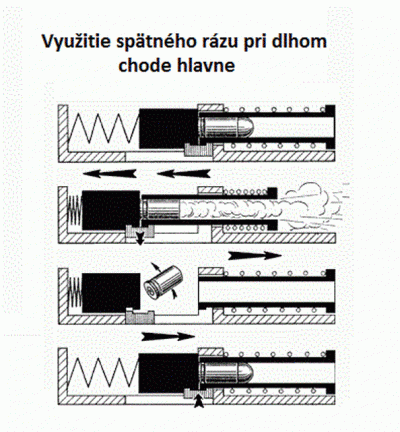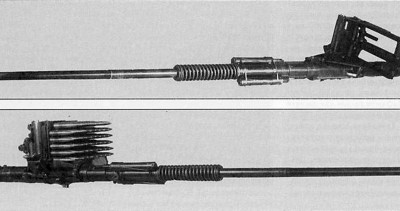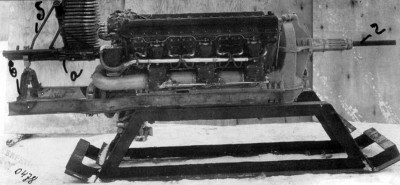| Název: Name: | MP-6 | MP-6 |
| Originální název: Original Name: | МП-6 (23-мм пушка) | |
| Výrobce: Producer: | OKB-16 | |
| Období výroby: Production Period: | DD.MM.1940-DD.05.1941 | |
| Vyrobeno kusů: Number of Produced: | ? | |
| Prototyp vyroben: Prototype Built: | DD.10.1940 | |
| Použití: Use: | skúšobne: Iljušin Il-2, Gudkov Gu-1, Pašinin I-21 | |
| Technické údaje: Technical Data: | ||
| Hmotnost: Weight: | 701) kg | 1541) lb |
| Ráže: Calibre: | 23 mm | |
| Náboj: Cartridge: | 23×152 | |
| Délka hlavně: Barrel Length: | 1361 mm | 4ft 5,57in |
| Celková délka: Overall Length: | 2455 mm | 8ft 0,65in |
| Používaná munice: Ammo Used: | náboj OZT - trieštivo-zápalný-trasujúci (снаряд ОЗТ - осколочно-зажигательно-трассирующий) náboj BTZ - priebojný-trasujúci-zápalný (снаряд БТЗ - бронебойно-трассирующий-зажигательный) | OZT (HEI-T) BZ (API-HC) |
| Výkony: Performance: | ||
| Maximální dostřel: Maximum Range: | ? km | ? mi |
| Rychlost střelby: Rate of Fire: | 600 ran/min | 600 rpm |
| Úsťová rychlost: Muzzle Velocity: | 900 m/s | 2952.8 ft/s |
| Poznámka: Note: | 1) s prázdnym zásobníkom | 1) with empty magazine |
| Zdroje: Sources: | Широкорад А. Б.: История авиационного вооружения. Краткий очерк. Харвест, 1999, ISBN: 985-433-695-6 авиару.рф | |
SOV - MP-6 (23 mm kanón)
MP-6 (23 mm automatic gun)
МП-6 (23-мм пушка)
MP- 6 origin and development
When the new 23×152 cartridge was constructed in 1937, two design bureaus were simultaneously given the task of constructing an air cannon for this cartridge. In the design bureau designated OKB-16 (OKB - opytno konstruktorskoye bjuro) this task was carried out by a team of designers led by Yakov Grigorievich Taubin and his deputy M.N. Baburin. The team included, in addition to two future world-famous weapons designers A.E. Nudelman and A.S. Suranov (creators of the NS-23, NS-37 and NS-45 cannons), also V.L. Taubkin (V.L. Taubkin), P.I. Gribkov (P.I. Gribkov ) and others. The second design bureau that was given the same task was CKB-14 in Tula. At this point we will anticipate events a bit and reveal that the result of their activity was the VJa-23 gun, produced in large series as the main armament of the Ilyushinov Il-2.
In designing the new air cannon, Taubin used his failed Taubin-Baburin AG-TB 40.8 mm caliber automatic grenade launcher project as a basis, making initial work proceed relatively quickly. The gun was given the designation MP-3, an abbreviation of the motor-gun designation, as it was to be mounted between the in-line engine blocks and fired by a hollow axis propeller. The number 3 denoted the rate of fire - 300 shots per minute. The weapon's automatics worked on the principle of using a long breech. This means that at the time of firing the breech and barrel are firmly connected (locked) and together, due to the recoil after firing, they move backwards a distance longer than the length of the cartridge. In the rear position, when the recoil spring (which can be seen in the picture in front of the barrel) is fully depressed, the breech is unlocked (barrel and breech disconnected), which continues to move backwards, during which it ejects the empty cartridge case and loads a new cartridge into the chamber as it moves backwards (see picture). Ammunition supply was provided by an unconventional 81-round square-shaped magazine, consisting of nine cartridges or cartridge belts of 9 rounds each. Typical for this type of automatic was the low cadence (rate of fire) - about 300 shots per minute. This was a stumbling block, as the Air Force officials demanded a cadence of at least 600 shots per minute. However, this could only be achieved by significantly shortening the barrel recoil length by at least a factor of three. After several attempts, including increasing the stiffness of the recoil spring, it was possible to achieve a cadence of 600-610 shots/min. This weapon was designated MP-6. However, the increase in cadence, and thus the increase in the speed of movement of the gun's components, had a major impact on the durability and reliability of the gun. Also, the unconventional magazine was the cause of frequent malfunctions (so-called jams) during firing.
In October 1940, the MP-6 gun finally reached the stage of practical tests on the polygon, which were conducted simultaneously with the tests of the competing VJa-23 gun. Due to the fact that the Soviet Union at the time did not have an aircraft on which to flight test such a massive weapon, one Messerschmitt Bf 110 was purchased in Germany. Instead of the original 20 mm guns, MP-6 and VJa-23 guns were mounted in the fuselage and wings. These tests showed the low reliability of the MP-6, mainly caused by the weapon's supply system. Another significant drawback was the necessity, due to the gun's profile, to overlap this special cover when mounted in the wing, which significantly increased the air resistance and worsened the aerodynamic characteristics of the wing. The VJa-23 proved to be a more reliable gun in trials, and the need to redesign the MP-6's supply to the cartridge belt was clearly demonstrated.
The MP-6 was also test-fitted to one of the early Il-2 types in 1940, but without much success. Weapon jams caused by an unsuitable magazine, the need to cowling it when mounted in the wings - the same problems as when mounted in the Bf 110.
The designers incorporated and over the course of a few months redesigned the cartridge feed to the sectional method, which they also successfully tested on a test fighter, the Pashinin I-21. Thus, in the summer of 1940, the redesigned MP-6 was again test-fitted to the Il-2. In addition, in 1940 intensive trials of the MP-6 were also conducted in the LaGG-3 fighter aircraft, specifically between the Klimov VK-105 engine blocks. The cannon still had trials at CAGI to come, but although these were not yet complete (e.g. no durability tests at all) and their preliminary results raised a number of doubts, the desire of the country's leadership for the rapid introduction of a 23 mm calibre cannon into the air force's armament was so great that, despite the above, by Decision No. 423 of the Defence Committee of 16 November 1940, the MP-6 was accepted into the armament of the Red Army Air Forces. Serial production was to take place at the Tula and Kovrov plants. Just four days later, on 20.11.1940, Taubin and his deputy Baburin were awarded a high state decoration - Lenin's Order.
However, during the assembly of the first serial guns into LaGG-3 in the spring of 1941, it was discovered that cracks were forming at the points of attachment of the gun to the VK-105P engine during firing, and it would be necessary to reinforce these points. However, even this did not help - the recoil was so strong that the gun was unusable in this aircraft. Something like this was referred to at the time as a failure to arm one's own fighter aircraft with guns and was considered treason! Moreover, the MP-6s of the first production run of Plant No. 66 exhibited a large number of glitches - one glitch for every 15 shots fired. For example, the ŠVAK gun statistically had one jam per 220 shots. Of course, it can be argued that the competing VJa-23 was also no flawless weapon at the time. The VJa-23 was just a prototype, while the MP-6 was a mass-produced weapon and introduced into service!
An imaginary cloud was beginning to gather over Taubin and his team, which eventually resulted in the tragic end of the chief designer and his deputy. Although still unable to establish mass production that would produce weapons that functioned as such, Taubin nonetheless redesigned the cartridge feed to belt-fed, marking a significant change for both plants in the problematically established production of weapons with 81-round magazines. In addition, Taubin's OKB-16 was given a new task with a gallows deadline: within two and a half months, to design, build and prepare for trials a new type of 12.7mm calibre airborne heavy machine gun, which would have no worse characteristics than the UB machine gun, but was to be half as light and have twice the service life! A similar task given in this day and age of computers and CNC machines would probably seem unrealistic, in 1940 even more so. To make matters worse, Taubin returns to work on the deferred 37mm calibre air cannon at that time, and even asks for the possibility of developing and producing an anti-aircraft gun based on the MP-3! One does not know what force drove the young designer into such self-destructive activities. Only one thing is clear - three or four simultaneous projects in progress, none of which were brought to a successful conclusion. A lot of resources and manpower were spent on their development, testing and production, which were lacking in the development and production of more viable projects.
In May 1941, production of the MP-6 was cancelled and production of the VJa-23 gun was accelerated.
Taubin and his deputy are arrested, charged, convicted and punished. Taubin to death by shooting, the sentence is carried out on October 28, 1941, Baburin to five years in prison. He does not survive the punishment, he dies in a forced labour camp on 30.08.1944.
Nowadays, a designer would pay for such a failure by losing his job and perhaps a lawsuit for compensation for wastefully used funds. In 1941, however, the situation was different. You build a weapon that, despite less-than-convincing results and incomplete trials, you put into armament and production - you get the highest state honors. If, after a while, it turns out that you have built a weapon that was not yet suitable for inclusion in armaments and production - you will be shot. That's how the Soviet regime worked at that time.
Shirokorad A. B.: Istoriya avionnoi вооруzheniya. A short essay. Harvest, 1999, ISBN: 985-433-695-6
авиару.рф
masterok.livejournal.com]
Reklama
Join us
We believe that there are people with different interests and experiences who could contribute their knowledge and ideas. If you love military history and have experience in historical research, writing articles, editing text, moderating, creating images, graphics or videos, or simply have a desire to contribute to our unique system, you can join us and help us create content that will be interesting and beneficial to other readers.
Find out more

